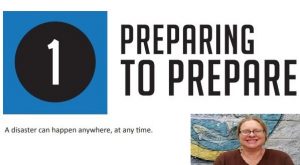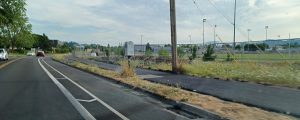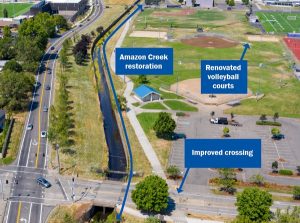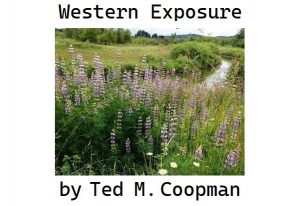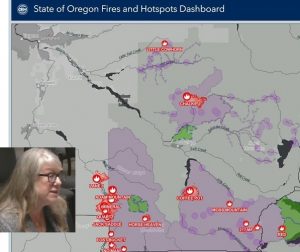Volunteers plant 150 trees along Upper Amazon Creek
7 min read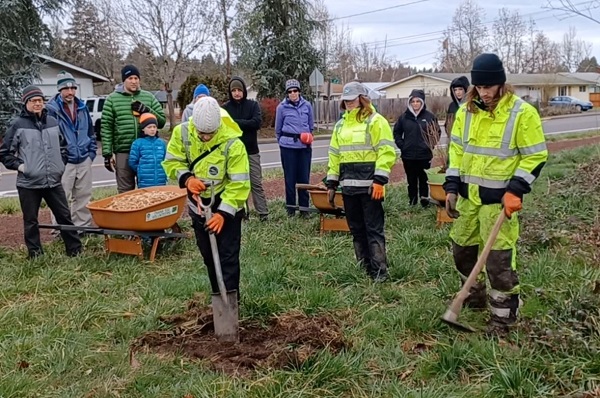
Volunteers planted 150 trees this month along Upper Amazon Creek. The trees are part of an overall plan for the entire Amazon Creek watershed.
[00:00:12] Lauri Holts (City of Eugene ecologist): There’s white alder, cascara, chokecherry, and bitter cherry. And those are generally all smaller stature trees. We have a lot of power lines right nearby. The alders will get a little wider more quickly, and the others are small stature trees.
[00:00:30] Everybody’s heard we have emerald ash borer in Oregon now. Or if you haven’t heard, you will be hearing, we don’t have it in Eugene yet that we know of but that’s going to be a real game-changer and I’ve been thinking a lot about that with regards to the Amazon Shading Plan and our next update.
[00:00:46] We’re really careful to select a diversity of species when we plant, although there’s kind of a limited palette of native tree species in Oregon. But it’s going to be more and more important if we get emerald ash borer here that starts taking down some of our Oregon ash, to have these species planted.
[00:01:10] Kelsey Irvine (City of Eugene): My name is Kelsey. I work for City Parks and Open Space as the native plant nursery manager, and I’m the volunteer coordinator for waterways. So obviously this is one of our main waterways in town. And so this is like, cool kind of work that I get to do with you all. Thank you again so much for being here.
[00:01:28] We’ve been planning this with Southeast Neighbors and Obsidians for a few months now, I mean, really going back to summer. It was really cool to have it all commenced and I think we got lucky with the day.
[00:01:39] We have about 150 trees we’re going to try to get in the ground today.
[00:01:42] We have four different species that we’re just going to mix as we go, so we’ll hope that we get a good mix and not all in a row of the same species.
[00:01:52] There’s some open areas on the creek here that need trees in order to shade over some of the water or help with bank erosion control and bank stabilization.
[00:02:02] The other thing that’s really important about the areas that we’re planting is that all of this neighborhood comes, like, stormwater does come all down into the creek. And so one of the things the plants do is help absorb that and keep it as clear as possible for downstream.
[00:02:15] And if you guys didn’t know it, one arm of the Amazon Creek actually is the City of Monroe’s water source. And so everything we can do in Eugene is going to be helpful to our neighboring communities as well.
[00:02:27] And so what we’ve done is from 33rd Avenue up to Fox Hollow, we’ve pin-flagged the entirety of the project so it’s going to be really easy for everyone to see a location to put a tree.
[00:02:41] So the plan is we we’re going to do a demonstration for you here, and then we’re going to split into two groups, where two-thirds are going to go north, and about one-third is going to go south. When we’re planting, some of the locations are maybe a little bit down the bank, so it might be a little bit steep.
[00:02:55] So just be careful. It could be slippery. Some of the spots, ‘cause it’s not on the trail, right, that we’re planting, there’s uneven ground, if you’re walking around.
[00:03:04] If you’re using tools, be aware. They, we always say the, you know, like, ‘the blood bubble’ basically, right? And if you think that you’re going to come in contact with anyone, if you had your arms straight out with your tool, then try to give space, right?
[00:03:15] It is helpful in these plantings to buddy up so that because the bare root there’s so little root mass, they don’t stand on their own. So it’s helpful to have a buddy with you to hold the tree so you can backfill.
[00:03:28] John Q: The demonstration showed how to use a hoedad to clear the turf, create a hole deep enough for the bare root, and then apply mulch.
[00:03:36] Kelsey Irvine: All you really need is the top inch or so of the turf to come off. Cause we’re not pulling roots, we’re just trying to get bare ground. The tool is heavy on the metal end. Let it do the job for you. You don’t need to use a lot of muscle. You’ll get tired quickly.
[00:03:53] Two-and-a-half, three-foot circle. And really the point of that is to keep the grass away from the tree so it’s not competing so much, at least at first.
[00:04:03] So you can see what we’re doing with the turf there. Grab that turf, flip it upside down, make a ring. We’re going to cover it with mulch anyway.
[00:04:11] John Q: They said it’s important to dig deep enough for the root, and at the right soil level.
[00:04:16] Lauri Holts: We still want to loosen up the soil and have enough of a space for them to grow and some of them have quite a deep root.
[00:04:24] So you may dig your hole and think you’re deep enough, get your tree from one of us, and then realize that you need to dig this a tiny bit more. And that’s okay. We can also do a little bit of root trimming. If it’s really long, let one of us know.
[00:04:40] But that’s going to be the trick with these, because what happens is our root then wants to go down again and it can end up circling, which won’t hurt it now, but when it’s got a big root, it can girdle itself.
[00:04:54] Dig as deep as you can. If you’re just frustrated, you can’t go that deep, you know, let one of us know, and we can trim some of it off. And Kelsey, if you have anything to add.
[00:05:05] Kelsey Irvine: I just want to reiterate that we’re not in a race. It’s really important that this, these are done well, no matter how long it takes. One of the reasons that it’s really important to put it at the right soil level is cause if it’s too deep, then water will collect. And these are small and they could get a fungus or have a rot situation happen. And it’s more likely when they’re little like this that that would happen than if they were bigger with a more established trunk, right?
[00:05:29] So it’s really important. And if you go too high, the water runs off. And again, these guys are so little and their root mass is so small, they’re going to be desperate for all the water they can get. So we just want to make sure that it’s right at soil level. The mulch will help, right? The mulch is for water retention, it’s also to keep the grass back, but certainly anything we do—correctly—will also be helping them along.
[00:05:54] So we’re going to do our best to water and if we don’t get it done today, we’ll water on Monday and it hopefully a day won’t be that big of a deal. (Yeah.)
[00:06:01] And you’re going to make the donut or volcano. Try to get the mulch four to six inches high in a ring around the tree, and then very little of it actually touching the tree itself. And you want a good fist or about six inches from the tree for when that ring starts to form.
[00:06:21] Lauri Holts: When you mulch, you’re going to leave around the plant kind of open. After you water, sometimes you’ll see soil subside and some roots exposed. So that would be the only reason not to water before you mulch. You might need to add a little more soil to the top if any roots become exposed in the water.
[00:06:41] The other trick in watering, is not dumping the water quickly or right on the plant itself. You can do it off to the side and kind of trickle it on, let it soak in with the clay. It’s going to probably not settle down very quickly. But it will percolate in and try to fill in.
[00:06:59] Natural area trees, so we’re not as worried about ’em, but make sure they’re roughly up and down. So this one’s not perfectly straight, which is fine.
[00:07:07] It just takes a little while. It’s just a little care, but a little love and care and take your time and they’ll thrive.
[00:07:21] Devon Mann (Southeast Neighbors co-chair and Sustainability Commission member): My name’s Devon Mann and I want to thank everyone that came out. And on behalf of Southeast Neighbors, thank you for coming out and thank you guys for making this happen, everybody.
[00:07:31] And John O(strom) for really making this happen. Yeah. Thank you. Thanks everybody.
[00:07:36] Kelsey Irvine: And just so you know, we have another project on Feb. 25 where we’re going to go from Fox Hollow to Snell.
[00:07:42] John Q: Southeast Neighbors and the Obsidians plant 150 trees along Upper Amazon Creek. To help with the next planting, contact Kelsey at the City of Eugene.
